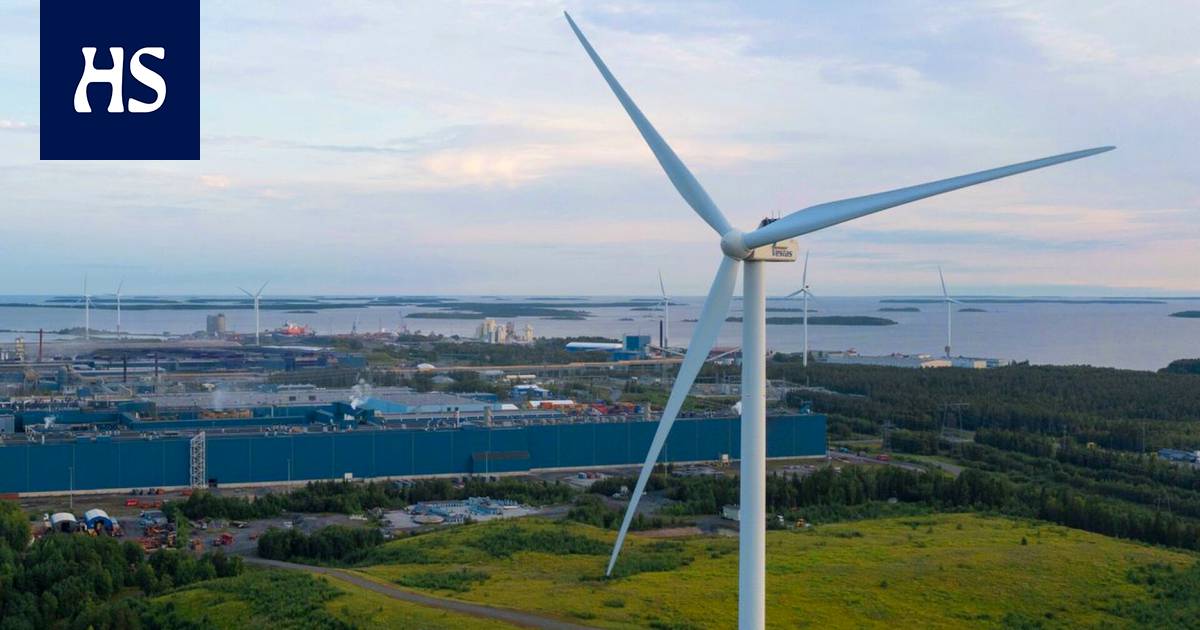The heavy generators of traditional power plants improve the power system’s ability to withstand disturbances. The growth of wind and solar power has forced to invent new ways to produce so-called inertia in the system or compensate for its lack.
Imagine a heavy rocky face that you turn with a crank. Getting the bike up to speed requires a lot of power, but maintaining the speed is quite easy. Now imagine trying to stop Tahko quickly. It doesn’t want to succeed.
The kinetic energy stored in the rotating mass of the stone resists stopping effectively, it seems to push the face forward.
In the electrical system, large rotating generators and electric motors behave in the same way. The kinetic energy stored in their rotating mass is of great importance to the operational reliability of the entire electrical system.
If there is a disturbance in the electrical system, for example a large power plant falls off the grid or a boundary line fails, the kinetic energy of the rotating generators automatically injects additional power into the grid and supports the 50 hertz frequency, which is vital for the operation of the electrical grid.
“Because of this, however, the rotation speed of the generators soon begins to slow down and the frequency of the electricity grid tends to decrease. In this case, more power must be supplied to the network from the reserves”, says the specialist Mikko Kuivaniemi from Fingrid.
Fingrid is a grid company owned by the state and pension companies. Its task is to ensure that Finns receive electricity without interruptions.
In the event of a disturbance, the power grid receives quick additional power within seconds from the frequency-controlled disturbance reserve of the electrical system.
The frequency-controlled reserve works in such a way that when the grid frequency drops, the automation system automatically opens the control cells of some hydropower plants. More water gets into the turbines and the electricity production efficiency increases rapidly.
There is also a lot of electricity consumption in the frequency-controlled reserve. In the event of a fault, the relays disconnect the consumer from the network.
In the event of a disturbance the next 15 minutes are crucial. The electricity shortfall is fixed with control electricity and, if necessary, with Fingrid’s own backup power plants.
The following
In the regulated electricity market, Fingrid conducts a continuous auction of who can increase electricity production or cut its consumption at the lowest price in each future hour.
When the power shortfall has been replaced with control electricity, the frequency-controlled reserve can be deactivated to wait for a new possible disturbance.
Big ones the power plants running the generators therefore give the electrical system about five seconds to react to a sudden disturbance. Large generators can be found, for example, in nuclear, coal and wood chip power plants. Hydropower turbines are smaller, but they also have mass.
These generators and also the electric motors of large industrial machines provide the electrical system with the inherent ability to resist a change in frequency in the event of a disturbance. This property is called inertia.
Nuclear power plants produce a particularly large amount of inertia, because their turbines are not only huge, but they also spin very fast.
In the system is, however, a growing problem.
Solar and wind power do not inherently produce inertia at all. The electricity they produce goes through a frequency converter or a rectifier, i.e. an inverter.
The kinetic energy stored in the generators of the wind turbines remains behind the frequency converter, as it were. Solar power plants don’t even have generators.
When a very large part of the electricity is produced by wind or solar power and even the big industrial motors are not used much, there can be very little inertia in the system.
The traditional reaction time of five seconds in the event of a possible disturbance is no longer enough, the resulting power shortfall must be fixed much faster, even in less than a second.
Otherwise, the frequency of the power grid will drop dangerously. A drop in frequency can cause the entire electrical system to crash at worst.
Network company Fingrid monitors the amount of inertia daily in advance.
“There have been situations of very low inertia, especially on summer weekends, when nuclear power plants have been under maintenance and consumption is also low,” says Kuivaniemi.
Two years ago, the Nordic grid companies started buying, in addition to the frequency-controlled reserve, a so-called fast frequency reserve, which reacts to changes in the frequency of the electricity grid in 0.7–1.3 seconds.
“
The traditional five-second reaction time is no longer enough.
Power plants are not capable of such a quick reaction. In practice, the reserve contains electricity consumption that can be quickly interrupted, such as industrial machines and greenhouse lighting, or very fast power sources, such as batteries.
Fingrid buys a fast frequency reserve in advance for use when inertia is predicted to be low.
Also the requirements of the traditional frequency-controlled reserve, which is activated in five seconds, are gradually becoming stricter starting next year. The reason is the decrease in the amount of inertia.
“For some of the hydropower plants, the new requirements will be challenging. In practice, the amount of reserves that can be offered from Finland will decrease,” says Kuivaniemi.
The companies that produce hydropower are now working to meet the new requirements. You get a good price for reserve electricity, and it is also important that Finland has enough of its own reserve in use.
During the winter, a supercapacitor capable of rapid power regulation will be installed in connection with the Kurkiaska hydropower plant, which is under maintenance. The power plant is in Kitine, which descends into the Kemijoki.
Hydroelectric plant an accumulator or a supercapacitor can be added to the side, which takes care of lightning-fast power regulation. During the winter, the Kemijoki energy company will connect a supercapacitor to one of the power plants undergoing renovation in the Kemijoki waterway.
“At the Kurkiaska power plant, we are experimenting with a supercapacitor, which is a very fast and efficient electricity storage. It would take care of the frequency deviation for the first few seconds at the same time as the power plant’s power is increased,” says the company’s operational manager Sakke Rantala.
This all happens automatically. That is why power plant maintenance includes a lot of automation installations.
According to Rantala, the capacitor would also save on the technology of the actual power plant, because the power plant would run more smoothly and the supercapacitor would take care of continuous, fast power regulation.
A supercapacitor can discharge power very quickly, even in milliseconds, but the amount of energy loaded into it would only last for tens of seconds at most.
UPM is also experimenting with supercapacitors and Fortum is connecting batteries to power plants.
Rotating rows according to Fingrid’s Kuivaniemi, it would be possible to replace the natural inertia produced by the generators with synthetic inertia. It means, for example, that the inverters, or rectifiers, of wind and solar power plants are programmed to produce inertia in the grid.
“Technology is developing in the world. It’s not ripe yet, but it’s coming. More generally, what kind of system services wind and solar power should produce in the future is under consideration.”
So far, it has made the most sense to solve situations with low inertia by introducing a faster reserve.
Even in their current form, wind turbines must be able to react to some disturbance situations. But in the future, other requirements can be placed on them to improve the stability of the network.
“
We are considering what kind of system services are required from wind and solar power.
Finland electricity production will rely even more on wind power in the future. At the end of the year, Finland already has more than 5,100 megawatts of wind power.
That’s a lot, because after the completion of the third Olkiluoto nuclear power plant, there will be about 4,400 megawatts of nuclear power in Finland.
At the end of 2025, according to the forecast of the grid company Fingrid, the power will be at least 9,000 megawatts.
According to Kuivaniemi, regionally, the growth of wind power already causes other problems than the lack of inertia, which is a problem at the level of the entire system. There are also challenges in maintaining the network voltage.
“Current wind power technology requires that traditional power plants generate voltage to the grid and the wind turbines synchronize with it. In some areas, there are not enough of these traditional power plants and the network is therefore weak and prone to disturbances.”
A solution has been developed for this problem as well: the voltage can be supported with a device called a synchronous compensator. In practice, it is an electric motor rotating in sync with the grid, whose purpose is only to support the grid.
According to Kuivaniemi, the same challenges are being wrestled with everywhere in the world, where a lot of wind and solar power has been built. That is why solutions are being developed worldwide.
“Synchronous compensators are already in use in many places around the world,” he says.
#Energy #Finland #dependent #wind #power #big #risk









